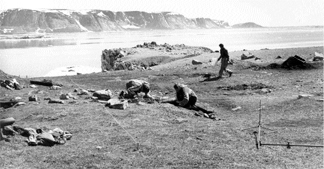 The year
was 1576. Sea captain Martin Frobisher set off from England in search of a northwest
passage to China. When Frobisher and his crew hit the Canadian Arctic, they
stalled in the ice and were forced to turn back. Before they left Canada, the
crew gathered some black rocks that resembled sea coal (used to heat English
homes), to prove to Queen Elizabeth I that they had found new land. Legend has
it that when burned in a hearth, the black rocks changed into a golden color.
Although tests on the black rocks were inconclusive at best, with merely a hint
of gold, the queen and other investors commissioned Frobisher and crew to return
to the new land to harvest gold. Two years and boatloads of ore later, English
assessors concluded that the black rock contained no gold. Now, 400 years later,
an archaeologist and a geochemist say that this was no accident — it was
the first gold swindle in the New World.
The year
was 1576. Sea captain Martin Frobisher set off from England in search of a northwest
passage to China. When Frobisher and his crew hit the Canadian Arctic, they
stalled in the ice and were forced to turn back. Before they left Canada, the
crew gathered some black rocks that resembled sea coal (used to heat English
homes), to prove to Queen Elizabeth I that they had found new land. Legend has
it that when burned in a hearth, the black rocks changed into a golden color.
Although tests on the black rocks were inconclusive at best, with merely a hint
of gold, the queen and other investors commissioned Frobisher and crew to return
to the new land to harvest gold. Two years and boatloads of ore later, English
assessors concluded that the black rock contained no gold. Now, 400 years later,
an archaeologist and a geochemist say that this was no accident — it was
the first gold swindle in the New World.On a tiny island in Canada, researchers excavate the remains of the ore-processing shops used to test supposedly precious-metal bearing ore by a British exploration team in 1578. Researchers have recently determined that the British team defrauded its investors in Canada’s oldest mining scandal. Image courtesy of Réginald Auger.
Over the years, only two plausible explanations for the gold scandal have been purported, according to an article by archaeologist Réginald Auger and geochemist Georges Beaudoin, both with Laval University in Quebec City, in the June Canadian Journal of Earth Sciences. Either the alchemists accidentally contaminated the rock samples with gold and silver while processing the ore, or they forged the results and defrauded their investors.
When Frobisher and his crew returned to the Arctic, they set up a camp on a tiny island off Baffin Land in Nunavut “where they found a vein of black ore — and where they were separated from the Inuit,” Auger says. They built two ore-processing shops with clay ovens that alchemists used to test for the presence of precious metals in the ore, in a process called assaying, he says. On visits to the tiny island, Laval and Smithsonian Institution archaeologists have found not only food such as dried peas and bread left by the 1578 Frobisher expedition, but also assay “shots,” or little beads of lead left over from assaying.
It was these lead beads that drew Beaudoin into the mystery. At the time, the preferred assaying method involved placing lead and smelting ore with the ore sample in a crucible in a very hot oven. The lead, acting as a sponge, would join to the precious metals and sink to the bottom of the crucible, in a process similar to that used today, Beaudoin says. Assayers recognized that the process often introduced low levels of contaminants (which could include gold or silver) into the ore, so it was possible that this “swindle” could merely have been an accident. Thus, Beaudoin and Auger devised a test to sample the lead beads.
They analyzed the chemical composition of five lead samples from Frobisher’s crucibles, and also combed the archaeological and historical literature to find all they could about the assaying results from 1576 through 1578. Their chemical analysis showed that four of the five samples contained no gold, and the fifth contained negligible amounts, Beaudoin says. “Our evidence shows no indication that this was an accident,” he says.
Furthermore, Beaudoin says, the host rock was black amphibolite — not a stone commonly associated with gold. Amphibolite, a metamorphic rock consisting primarily of amphibole and plagioclase, is typically derived from basalt. Unless hydrothermally altered, the amphibolite would be unlikely to contain any significant amount of gold, says Brent Owens, a petrologist at the College of William and Mary in Williamsburg, Va. Additionally, amphibolite does not resemble coal, other than in color, Owens says, so “fraud seems like a good conclusion in this intriguing old detective story.”
All the signs, Auger says, point to fraud. In addition to lack of evidence of accidental contamination, there is a lot of historical “contradictory evidence” that should raise some red flags, he says. First, out of three original tests, two proved inconclusive for gold. Second, all of the assaying log books were allegedly lost out of a porthole at sea, so when Frobisher’s assay team returned to England, investors could not see what had been discovered in Canada. Additionally, it is well-known that people at the time would occasionally salt ore samples with gold — even coins — to obtain funding for exploration, Auger says.
The parallels between this case and Canada’s 1997 Bre-X gold scandal, where the company had salted its gold samples and vastly overstated the value of its gold deposit in Indonesia, are striking, Beaudoin and Auger say. In both cases, there were clear indications that the reported amounts of gold were suspicious. And, they write, “power and greed were likely the ultimate reasons for not objectively assessing all assay results.”
Megan Sever

